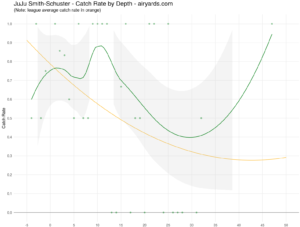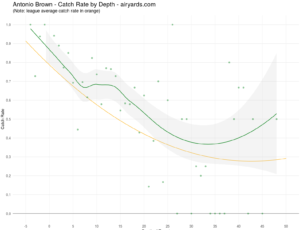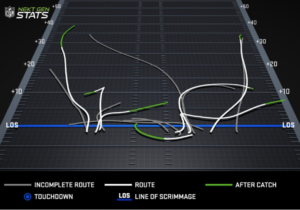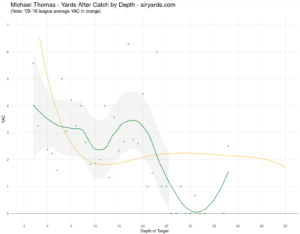______________
WEEK 1 ROSTER BREAKDOWN
Point Total: 218.66
Reminder: I always write my initial diagnosis of my roster right before games kick off, in order to capture my honest thoughts on the build. Here are those thoughts.
Second reminder: this is my DraftKings roster, as that’s where the majority of my play goes; but the breakdown of thought process is beneficial for all sites and styles of play.
What I Wrote Before Kickoff:
This is one of the rare weeks in which I have a totally different lineup in cash games than in tourneys. I thought from the beginning of the week that this might be the case because of Christian McCaffrey, but I ended up using him in both lineups. The change actually ended up coming from my desire to avoid the wind in Cleveland in cash games, but still take the upside of Antonio Brown in tourneys.
Cash Lineup:
Drew Brees
Carlos Hyde
Alvin Kamara
Emmanuel Sanders
Courtland Sutton
Michael Thomas
Jack Doyle
Christian McCaffrey
Ravens
Tourney Lineup:
Deshaun Watson
Carlos Hyde
Alvin Kamara
Danny Amendola
Courtland Sutton
Antonio Brown
Jack Doyle
Christian McCaffrey
Ravens
Hyde is locked in for me as a 20-touch back in a good matchup, with a game that should favor the run. At only $4500, he’s one of the easiest plays for me on the week, and the only challenge was deciding if game theory called for me to use James Conner over him in cash. Once I started taking the weather into account, Hyde came out on top for me.
I wanted to move off Kamara in tourneys in order to avoid the ownership (my team about an hour before kickoff had David Johnson), but there is just such a low likelihood of Kamara failing. While DJ could outscore him, this is a spot where it makes sense to eat chalk. I also expect Kamara’s ownership to go down in the $2160 tourney, while I expect DJ’s ownership to go up. Since that’s the main tourney I focus on, it makes sense to take the more locked-in overall play. (Plus, I just really, really liked the way salary as a whole worked out on this team.)
Typically, an Amendola/A.B. pairing would make more sense in cash, while going Emmanuel Sanders and Michael Thomas would seem more tourney-driven. But with the wind in Cleveland, I don’t feel it’s necessary to have A.B. in cash. I didn’t need the extra salary, but Sanders is a nice fortification with that $800. He and Sutton can both post a good game together, so that’s not a concern for me.
Sutton was lock-button for me this week, as I talked about on the Square Table and in my Player Grid. No surprise to see him on the team.
Jack Doyle grew on me as the week moved along (as alluded to in the Square Table, and talked about directly in the Player Grid). I like Ryan Griffin about an equal amount, but the money was there and Doyle’s role is so secure. No reason not to go here.
Probably the toughest decision this week was leaving Kareem Hunt off my main team. Up until about 30 minutes before kickoff, I assumed he would be there. But this roster came together and just made so much sense. I expect a big game from Hunt and still have exposure to him — but that exposure now comes from a smaller percentage of my bankroll than I anticipated all along. Christian McCaffrey is obviously no slouch! I love his floor, and he has clear upside for 25+ points if everything goes according to plan.
I wanted to differentiate at defense in tourneys, but the salary just worked out too easily to take the locked-in points on the Ravens. I think the Bengals probably have a 35% chance of outscoring them, at a lower price tag, but there was nowhere I wanted to use that money, so I stood pat there.
Looking Back On This Roster
Obviously, there are two mistakes that stand out here:
1) This was probably only the third or fourth time in the last five years that I have not used the same team in cash games and single-entry/high-dollar tourneys. I had a profitable weekend with such a strong showing in cash games (and I did have that cash team in a pair of less-lucrative tourneys), but I could have had a really nice weekend if I had stuck to my process.
2) Obviously, Hyde over Conner was a mistake in cash. I got too freaked out by the weather, and with A) the Browns having a top-five run defense, and B) the weather seeming likely to limit Conner’s targets, I sided with the guy who had the better matchup. We could still make a strong case that Hyde (who graded out just as highly in preseason this year as Conner, and who was quietly one of the most effective backs in the league last year) was still a strong game theory play in tourneys, given the huge ownership gap and the favorable data points he carried. But at the very least in cash games, I should have sided with the higher guaranteed touches and the superior coaching staff. Up until about 30 minutes before kickoff, I planned to have Conner…but the weather concerns got to me, and I made a misstep there.
While I moved off Conner on my main roster 30 minutes before kickoff, I also dodged a couple bullets at that point.
The first was Ryan Griffin, who had zero catches in spite of being charted with five targets (and actually being targeted seven times in all). He also had two end zone targets — each of which was a miserable throw by Watson to an open Griffin. This is the kind of play that absolutely sucks, and that has to simply be brushed off as variance. If you can roster a guy who will get five to seven targets for only $2800, you have to feel good about the position you put yourself in.
The second was Kareem Hunt, who might be slipping into the “Never in Cash” category. One of the things the NFL Edge has been good at over the years is getting inside coaches’ minds to get a feel for how they will attack a particular defense. The best ever example of this was when we predicted the Jonas Gray game against the Colts a few years back, and a more recent example is the Raiders/Rams game that just took place, for which we looked at the reasons why Jared Cook should see a spike in targets. But while everything lined up this last week for Kareem Hunt to see monster usage, we ended up witnessing the reality of the concerns expressed in the Week 1 writeup of that game (namely: that Sundays will sometimes end this year, and we’ll all wonder how Hunt did not touch the ball more). While the NFL Edge presented all the facts on both sides of the coin for Hunt (the reasons to feel great about his upside, and the reasons to be concerned about his floor), I personally moved more and more toward Hunt in the latter half of the week, believing there was just no way Hunt would fail to see the usage he deserved. In other weeks, this might have been more justifiable; but with so many strong plays available on the week, I’m chalking this one up as a mistake, as I chose to blatantly ignore the concerns I had laid out myself in the article.
Finally, I would like to point out that my boy Courtland Sutton saw five targets — which was more than a chalky Keelan Cole drew this week for the Jags. I was expecting six to eight targets for Cole and five to eight for Sutton; with Sutton seeing five targets (it was actually six, but there was a pass intended for him that was batted down at the line) and showing his huge upside on both catches, he’s a guy I’m marking down as a “strong process play” that simply didn’t hit this week. Similar to Griffin, I’ll always be happy if I’m grabbing six or more targets to a high-upside player for such a small percentage of my salary cap. Remember: spiked weeks matter! If you can grab a low-priced guy with spiked-week potential, and this enables you to also fit in high-priced guys with spiked-week potential, you will win a lot of money over time.
I’m really proud of the overall accuracy of the Week 1 NFL Edge, and of how many things we were able to nail. And while I know a lot of you had a winning Week 1, I also realize some of you had a losing Week 1. For those of you who ran into the wrong plays last week, I want to strongly encourage you to A) assess process first and foremost! — and B) learn from the plays where you made mistakes in your process; but also, be willing to give yourself credit for the places where the process was solid and the plays just didn’t hit. It’s only one week, and we’ll all have losing ones throughout the season; the key is to put yourself in position to win big on the winning weekends — and to put yourself in position for such weekends as often as you can.
The second week of The One Week Season starts today.
Let’s start getting ready.
Week 2 is always one of the most enjoyable weeks of the season for me. The work is still fresh and new; the excitement is still high in the DFS community; and for the first time, we get to begin incorporating huge chunks of new knowledge into the pile of things we already know.
At first glance, it appears that this week’s slate will hinge on the performance of a number of high-priced guys. Not only did guys like Julio Jones, Michael Thomas, Alvin Kamara, and James Conner smash this last weekend, but they also find themselves in smash spots once again. Recency bias will elevate ownership on these guys, and these guys are likely to perform well, which makes this an interesting week from a strategy perspective.
While every NFL Edge article is focused on uncovering the players likeliest to have a good game, the second layer we will be looking for this week is broken down into two parts:
1) Which guys have a respectable shot at outperforming the chalk?
2) Which low-priced players open the greatest combination of “floor” and “ceiling” to our rosters.
Obviously, a case can always be made for constructing your rosters in an entirely different manner than the rest of the field (and this week, especially, it seems “the rest of the field” will find themselves using a Stars & Scrubs approach — which means you could go with a more mid-tier roster in tourneys simply to do something that most others aren’t doing). But if rolling with a Stars & Scrubs setup, it will be important to determine whether it makes sense to go with the chalky stars, or if you can instead differentiate by going off the board; and it will be particularly important to ‘think for yourself’ in tourneys on the lower end of the price range. I’m going to dive into a couple thoughts on this, and then we’ll get started with the first game of the weekend.
Thinking for yourself on the cheaper guys:
Typically, when someone like Alvin Kamara is chalk — that is to say, when a high-priced guy with tons of talent and a great matchup is chalk — the reason for this player’s popularity can be boiled down to a simple statement: “This player not only has a high ceiling, but he is also highly unlikely to fail.”
On the other hand, when cheaper guys become chalk (a great example being Keelan Cole last weekend), it is typically less because this player is “highly unlikely to fail,” and more because that simply happened to be the player who everyone started talking about.
If we find that it is necessary to eat chalk at the top, we can still set ourselves apart from the field in tournaments by thinking for ourselves on the lower end of the price range. This may mean going out on a limb in GPPs with a cheap guy who no one else has really noticed; but on a week such as this, that can sometimes be exactly what it takes to win.
Let’s dig in.
Let’s think for ourselves!
And let’s uncover who the good plays are.
Get your Game Notes ready. Let’s go.
UPDATES MADE:
Devonta Freeman Out (Sept. 15)
Washington Total Rising (Sept. 15)
Titans’ Offensive Mess (Sept. 15)
Joe Haden Doubtful (Sept. 15)
Marquise Goodwin Out (Sept. 15)
Pats/Jags Question Marks (Sept. 15)
Josh Gordon Out (Sept. 15)








You must be logged in to view collective notes about a game.
You must be logged in to add notes about a game.